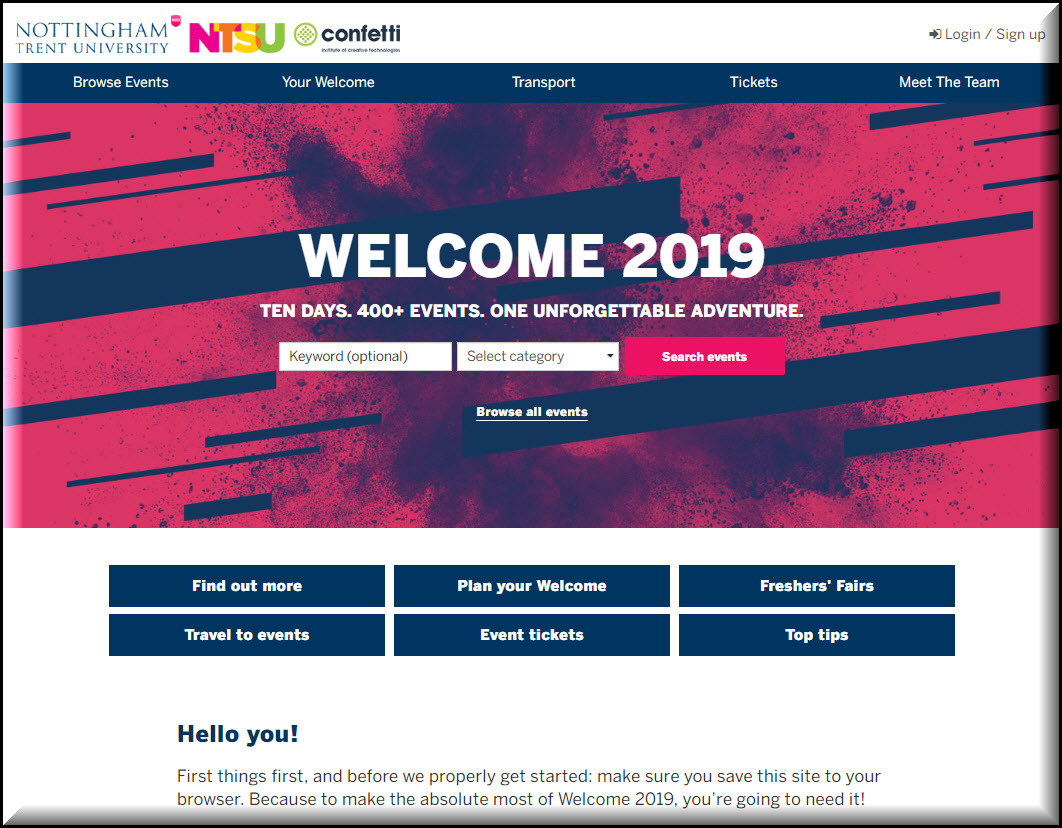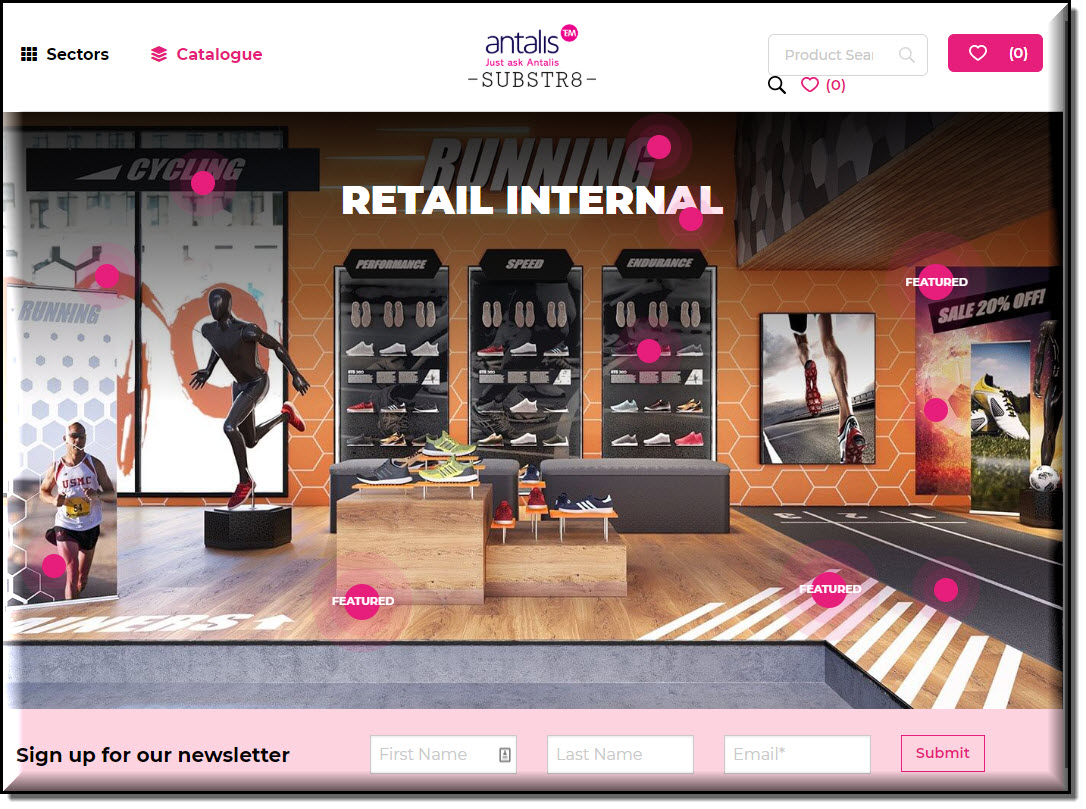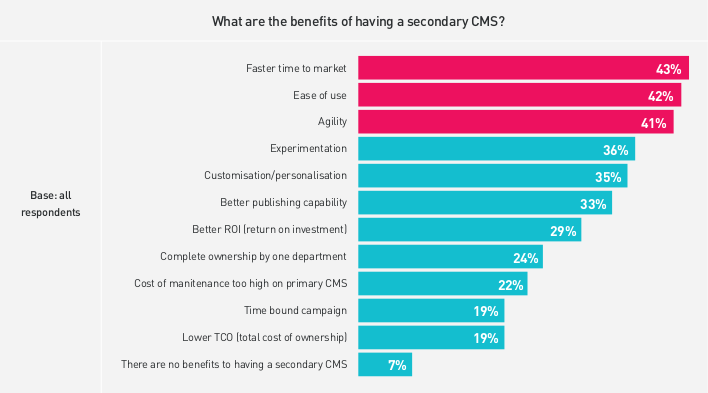A survey of 300 marketing decision-makers undertaken by market research experts VansonBourne found that more than 60% of survey respondents are using more than one CMS, with 49% looking to introduce a secondary CMS in the next year. Multiple CMS use in the enterprise is up 13% in 2019 from 2017 (from 53% to 60%).
Definition: what is a secondary CMS?
A secondary CMS is an additional content management system that companies use alongside their primary one.
In essence, it means a dual operation, using the most appropriate CMS for the task at hand.
Typically, a secondary CMS system is used to achieve objectives that the primary CMS can’t complete. In many instances, the secondary CMS is used for specific campaign driven activity.
The kinds of campaigns that might call for a secondary CMS might include:
- campaigns that need a microsite to be launched very swiftly such as a pilot or prototype
- campaigns that require custom integrations and tailoring for a one-off project
- projects that are blocked because of a shortage of primary CMS skills
- microsites that need an easy to use block-based editor suitable for non-technical staff
- campaigns that require the nimbleness to flex permissions and workflows to the task at hand
- campaigns that do not require the full complexity of the primary CMS and associated processes and procedures
WordPress as a secondary CMS in Higher Education
The WordPress development team at Hallam built the Nottingham Trent University’s Welcome Week Site using WordPress as the secondary CMS.
The main NTU website is powered by The Squiz Matrix specialist enterprise-level CMS used widely to support complex digital experiences in the higher education sector.
The “Nottingham Welcome Week” project required fast, flexible, fully functional microsite implementation. Most importantly, NTU’s highly skilled in-house CMS team were focusing on their own core projects. The choice of WordPress enabled the inhouse NTU team to leverage external skills and resources for an inexpensive, successful launch.

WordPress as a secondary CMS in Manufacturing
Antalis is the UK and Ireland’s leading supplier of large-format substrates for interior and exterior visual communications.
The Antalis team needed an interactive Visual Communications Product Selector that would enable clients to explore their full product range and find the right media solutions for their business.
The team at Antalis have selected Jahia DX as their primary CMS to build their Digital Experience Stack (DXS.) They have also identified in addition to their enterprise solution, they required an inexpensive and flexible CMS to work in tandem to deliver smaller nimble projects that would work alongside their large scale projects.
The web development team at Hallam built Substr8 Interactive for Antalis, delivering a swift, low-cost solution with a demonstrable return on investment.

Why WordPress?
We already know that WordPress powers over a third of the internet. With 66% of companies currently using it, it’s often the logical choice for many high-growth companies.
Even enterprise companies (5,000+ employees) are making the switch from the likes of Adobe, as WordPress can help to fulfil their ever-evolving digital needs.
As WordPress’ CMS system continues to improve its sophisticated functionality and usability aspects, companies are typically using it to create microsites, develop scalable intranets, and more.
When it comes to secondary CMS systems, WordPress is leading the way at 27%. In fact, enterprise companies are three times more likely to choose WordPress for their secondary systems, compared to another CMS.
31% of respondents viewed ROI as a major benefit of using WordPress. No other CMS scored higher than 27% and the average for all other CMSs was only 20%. Further, for those surveyed who are already using WordPress, 38% saw ROI as a major benefit making the case that once an enterprise is using WordPress its ROI is even more pronounced.
Should you be using a secondary CMS?
It’s no longer the norm to use just one CMS system. 60% of organisations currently have two systems, and of those that don’t, 49% revealed they were considering introducing a second CMS in the next 12 months.
If you’re wondering whether you should be using a secondary CMS, consider whether you have any strategic objectives that your current primary CMS can’t fulfil, whether it’s due to scalability, functionality, ease of use or flexibility issues. Using multiple CMS can bring increased agility, ease of use and faster time to market.
If you want to post regular content, then you may choose to use a secondary CMS, so that it doesn’t impact other aspects of your website. Research has shown that secondary CMS’ are 60% more likely to be used for blogs, and 21% more likely to be used for content hubs – so they bring clear value for content.

What are the benefits of using a secondary CMS?
100% of businesses surveyed who were actively using two CMS’ said there were benefits to it.
Faster time to market
CMS’ are great at publishing a variety of content, but because they often need to be able to integrate with other business systems, it means that any upgrades or changes need to be handled carefully to ensure there aren’t any negative knock-on effects.
The result of this, is that the process of rolling out new features is slowed down, making it continually harder for companies to keep up with their customers’ changing demands and expectations.
However, a secondary CMS can solve this issue; as businesses can test and build a new campaign, product or service independently of the primary CMS, making the turnaround much quicker.
Ease of use
With continuous amendments to CMS’ user-interface designs – and in particular, WordPress – they are becoming increasingly easy for non-digital and technical people to use and publish content. It also means that other departments besides IT and marketing can retain control when publishing their own digital comms.
While you may be able to identify a legacy system that can carry out your newly identified job, the problem lies with the shortage of staff available to be trained. Therefore, rather than making any potential mistakes on legacy systems, an easy-to-use secondary CMS such as WordPress is the ideal option because it’s more intuitive and easy to use.
Agility
Having a secondary CMS enables product teams to take ownership of a new product, service or system; enabling them to roll out experiments that are independent to the larger systems that the rest of the business uses.
This means that new products or services can be rolled out quicker, as they can be trialled at low costs; so winning ideas can be advanced, and the less successful ones can be left, before they start racking up unnecessary costs.
Why choose WordPress for a secondary CMS?
The main benefit of WordPress, according to its users, is its open-source nature, which means it’s completely customisable. While there are loads of plugins to choose from, there is the ability for you to create your own plugins if a feature you want doesn’t exist. This means that your CMS system is completely personalised to your business and your needs.
Risks of using a secondary CMS
There are many benefits to using a secondary CMS, but there are risks to consider too – you need to think about both of them to determine which one outweighs the other.
Higher costs
Naturally, bringing in another CMS system will incur higher costs than if you were to just stick with one. However, if you offset that against the opportunities a secondary CMS brings – i.e. the ability to bring new products and services to market faster, resulting in more sales and revenue – then the investment is worth it.
More room for error
As introducing a secondary CMS brings the need to test multiple systems, there is a greater room for error. Nevertheless, there is a very real threat of using a primary CMS and rolling out changes and them having a detrimental effect on the whole website. At least if there were to be any issues, it would be confined to that one section, instead of the entire site.
Need for training
A new system means that staff will need to be trained on it. However, those that were surveyed admitted that while their business initially experienced a rocky patch, employees were much happier once they were comfortable with using the new CMS system, resulting in higher quality work being produced.
Yet training itself isn’t necessarily an issue – those surveyed said that while they initially experienced a rocky patch, they found their employees were happy once they were comfortable with it, and subsequently, the work produced was of a higher quality.
The future of secondary CMS working alongside Enterprise applications
The future shows no signs of the popularity of secondary CMS’ slowing down. 49% of companies who use one CMS, have said they will invest in a second one; and out of the companies who don’t currently have any CMS’ (which is a tiny percentage), 22% said they’d use WordPress.
With more companies looking to choose WordPress, it could soon surpass Adobe to be the number one content management system, due to its agility and customisable nature. Once again WordPress and Adobe Experience Manager are battling it out for the top spot. While Adobe Experience Manager (AEM) remains the most commonly used CMS overall (68%), WordPress is neck-and-neck with it (66%) and has double the lead over AEM in the secondary CMS market (28% vs 14%).
So, if you’re looking for an agile system where you can regularly publish content and roll out new features without having to worry about the potentially detrimental effects it could have to the rest of your website, a secondary CMS might just be the answer.
Have you just learned something new?
Then join the 80,000 people who read our expert articles every month.







